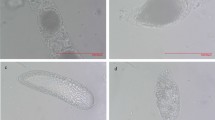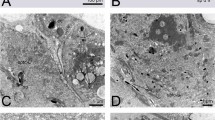Abstract
AN investigation of the ethology of this chironomid has been carried out by a team of investigators from the Entomological Research Center of Florida State Board of Health, and a report of the results is under preparation. During this work it was found that the males frequently carried a spermatophore between the claspers. This position is an artefact as the spermatophore is normally carried inside the genital tract of the male, but when killed it is ejaculated into a position which probably is the one used during the copulation.
This is a preview of subscription content, access via your institution
Access options
Subscribe to this journal
Receive 51 print issues and online access
$199.00 per year
only $3.90 per issue
Buy this article
- Purchase on Springer Link
- Instant access to full article PDF
Prices may be subject to local taxes which are calculated during checkout
Similar content being viewed by others
References
Lindner, Erwin, ‘Die Fliegen der palæarktischen Region’, 1, (Stuttgart, 1949).
Séguy, E., ‘La biologie des diptères’. Encyclopédie Entomologique, (Paris, 1950).
Thienemann, August, Die Binnengewässer, 20 (Stuttgart, 1956).
Imms, A. D., ‘Textbook of Entomology’. 9th Edit. by O. W. Richards and R. G. Davies (London, 1957).
Khalifa, Quart. J. Micro. Sci., 90, 281 (1949).
Author information
Authors and Affiliations
Rights and permissions
About this article
Cite this article
NIELSEN, E. Copulation of Glyptotendipes (Phytotendipes) paripes Edwards. Nature 184, 1252–1253 (1959). https://doi.org/10.1038/1841252a0
Issue Date:
DOI: https://doi.org/10.1038/1841252a0
This article is cited by
-
Structure and function of the spermathecal complex in the phlebotomine sandflyPhlebotomus papatasi Scopoli (Diptera: Psychodidae): II. Post-copulatory histophysiological changes during the gonotrophic cycle
Journal of Biosciences (2005)
-
�ber die Spermatophore von Boreus westwoodi Hagen (insecta, mecoptera)
Zeitschrift f�r Morphologie der Tiere (1974)
-
Funktionsanatomische untersuchungen �ber die abdomentorsion bei der m�nnlichen imago von Clunio marinus Haliday (Diptera, Chironomidae)
Zeitschrift f�r Morphologie der Tiere (1973)
-
�ber die biologie blutsaugender simuliiden (diptera)
Zeitschrift f�r Morphologie und �kologie der Tiere (1965)
Comments
By submitting a comment you agree to abide by our Terms and Community Guidelines. If you find something abusive or that does not comply with our terms or guidelines please flag it as inappropriate.



